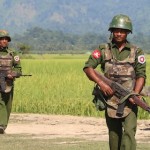Three years after an illegal military coup deprived Myanmar of limited democracy, the nation continues to fight its inner demons. Dubbed the ‘sick man of Southeast Asia’, it sees no light at the end of the tunnel as its military regime, the political class, and ethnic organisations persist with the violent conflict. This civil war has little hope of a clear victory for anyone.
Myanmar is a large multi-ethnic nation, located in a strategically significant neighbourhood. What happens in the country impacts its five neighbours: China, Laos, Thailand, Bangladesh, and India. Its fundamental tragedy lies in the historical reality that neither before nor during British colonial rule did it complete the task of nation-building — the crafting of a unified polity where its Bamar majority and a mixture of ethnic and religious minorities could live peacefully. Decades of military rule complicated the situation and the latest coup compounded it.
Two pillars of the power architecture — the political class and ethnic groups — are ranged against the third — the military; now, all three are facing trouble. The political class, represented by the unrecognised group called the National Unity Government (NUG), has defied the odds to assert itself through militia units called the People’s Defence Forces. They have won many battles against the army, especially in rural Bamar areas. The NUG has articulated its vision of a ‘federal democratic union’. But due to the regime’s ruthless suppression, its leaders operate underground or from Thailand. Opponents dismiss it as an entity existing only in cyberspace, but it has some political weight.
The ethnic armed organisations have inflicted a heavy toll on the Myanmar military along the Thai border in the south-east and the Chinese border in the north-east. The victories secured at the end of 2023 by the Three Brotherhood Alliance comprising the Myanmar National Democratic Alliance Army, the Arakan Army, and the Ta’ang National Liberation Army shook the army as nothing else had done before. Yet, ethnic organisations remain divided: some oppose the army, some support it quietly, and some stay neutral. Besides, some anti-army factions are active only when they are assured of China’s backing.
The most powerful pillar of the power architecture — the military or Tatmadaw — has never faced such a dismal situation. Most people are opposed to it, viewing it as an usurper and oppressor. Worse, it is seen as incompetent. Its failure to prevail over the resistance has weakened its morale. There is now considerable discontent within the military against its current leadership. The media reports that the days of Commander-in-Chief Min Aung Hlaing are numbered. Experts say that the second in command, General Soe Win, could assume leadership. Whether he has the right blend of firmness and resilience is not known.
Given this situation, it is not surprising that the international community has failed to help Myanmar. Various attempts by the United Nations, ASEAN, Japan, and Myanmar’s neighbours have been unable to move the country towards reconciliation. In particular, that the military has resiled from the ASEAN’s Five Point Consensus has dashed the region’s hopes for a settlement.
India’s policy of maintaining cordial relations with the government while also supporting the cause of democracy has served both countries well and strengthened bilateral ties. But the situation now is different from the pre-coup years. When the polity worked in unison to make the experiment with hybrid democracy work, India was helpful. Now with divisiveness and violence as the nation’s defining features, this policy needs a review. India should balance its friendly ties with the military government while broadening the space for engagement with other stakeholders. At the same time, it must not interfere in Myanmar’s internal affairs. Only then can India protect its national interests.
Several policy adaptations should, therefore, be considered. First, the inflow of refugees into Mizoram and Manipur has risen. There is also greater activism of Myanmar-based anti-India insurgents indulging in illegal activities along the border. This, in turn, has aggravated the security situation in Manipur. The refugee burden is a special concern for Mizoram. All this has compelled India to undertake fencing along the entire length of the border. Besides, the 2018 India-Myanmar agreement on the Free Movement Regime is under reconsideration.
Second, communication links with certain components of the resistance such as the Chin National Army, Arakan Army and the NUG need to be established, as they gain the upper hand in battles against the military in areas bordering India.
Third, a strong message of the need for cessation of violence and restoration of normalcy should be relayed to both the government and the resistance. The ‘transition to a federal democracy’, which India supports, can only come later. Fourth, India should consider convening a Peace Conclave of senior officials from the member states of the Quad and the ASEAN Troika comprising Indonesia, Laos and Malaysia. The conclave can make a dispassionate evaluation of the situation and offer Myanmar a blueprint and practical assistance in moving towards security and stability.
Finally, seeking immediate freedom for Daw Aung San Suu Kyi from her unjustified solitary confinement should be a key element in the calculus of the conclave. Ms. Suu Kyi, who is still the most popular leader, holds the key to unlocking a better future.
Rajiv Bhatia is Distinguished Fellow, Foreign Policy Studies, Gateway House.
This article was first published by The Hindu.


